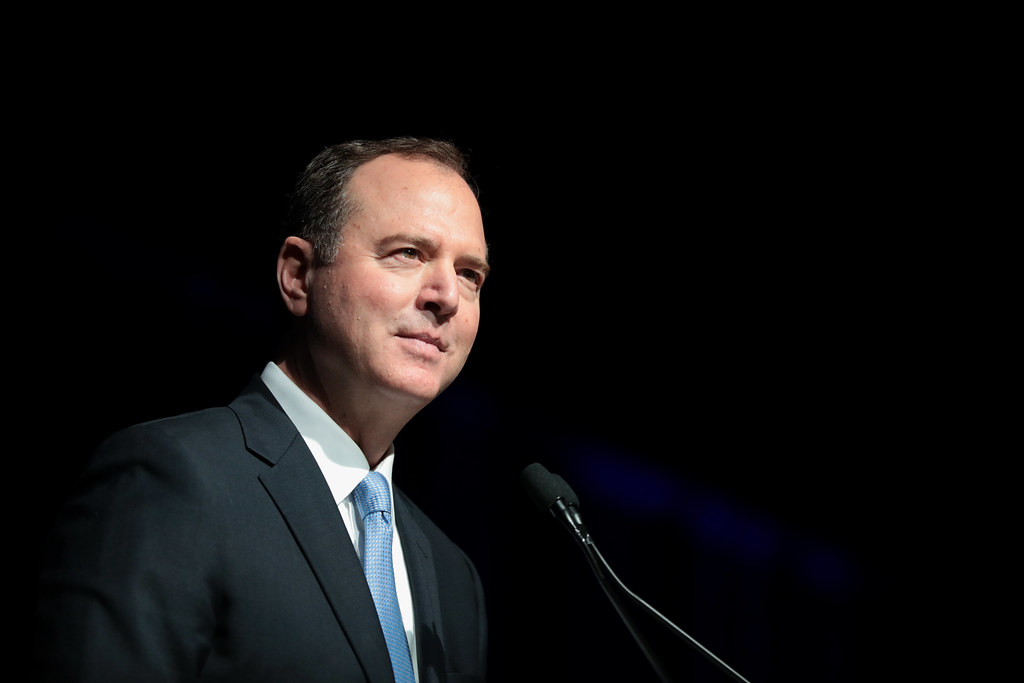What’s in the House Resolution on Impeachment?
On Oct. 29, Chairman of the House Rules Committee James McGovern introduced House resolution H.Res.660, along with a fact sheet, outlining procedures going forward for the impeachment inquiry into the president.

Published by The Lawfare Institute
in Cooperation With

On Oct. 29, Chairman of the House Rules Committee James McGovern introduced House resolution H.Res.660, along with a fact sheet, outlining procedures going forward for the impeachment inquiry into the president. The resolution sets the stage for the next phase of the impeachment investigation—which will have a decidedly more public face than the proceedings thus far. On Oct. 30, after robust discussion and the rejection of 18 amendments offered by Republicans, the Rules Committee reported the resolution favorably with a 9-4 party-line vote. It will be taken up by the full House on Thursday.
First, the resolution directs all six committees instructed by Speaker of the House Nancy Pelosi to participate in the inquiry—Intelligence, Financial Services, Foreign Affairs, Judiciary, Oversight and Reform, and Ways and Means—to “continue their ongoing investigations as part of the existing House of Representatives inquiry.” This posture—directing a continuation of work rather than authorizing the inquiry—reflects House Democrats’ long-standing assertion that the impeachment inquiry need not be specifically authorized by the full House to be valid. In addition, it would seem the scope of the inquiry, at least for now, is not strictly limited to issues related to President Trump’s conduct with respect to Ukraine. It is hard to say whether issues being investigated in other committees will eventually find their way into articles of impeachment, but this resolution certainly leaves that possibility open.
The resolution clearly puts the Intelligence Committee—and its chairman, Rep. Adam Schiff—in the driver’s seat for an initial set of public hearings. Schiff gets to call open hearings for purposes of the impeachment investigation, write a report including findings and recommendations for the Judiciary Committee, and make the report publicly available. He is firmly in the lead, though there is also a nod to the accompanying role played thus far by the committees on Foreign Affairs and Oversight and Reform, with which Schiff must consult in preparing the report. Schiff is also authorized to make publicly available the transcripts of depositions taken over the past few blockbuster weeks “with appropriate redactions for classified and other sensitive information.” This speaks to Republican complaints of inadequate transparency, while preserving at least some chance of protecting the identity of the Ukraine whistleblower if Republicans succeed in including the whistleblower’s name in deposition transcripts, as they have reportedly been trying to do.
The resolution also sets up a structure for such hearings that departs from the House’s usual practice: The chair and ranking member of the Intelligence Committee will have time at the beginning of public hearings—potentially as much as 45 minutes each—in which they can ask questions themselves or yield to staff members to question a witness. Thereafter, the committee would move to the regular five-minute rule, back-and-forth from Republican to Democrat, which is the usual approach. This hearing structure deviates from the current House Rule XI, Clause 2(j)(2), by providing a longer period of uninterrupted questioning—one reason this resolution would need to be voted on by the full House. This provision may be a response to the criticisms of the disjointed nature of impeachment investigation hearings conducted by the Judiciary Committee over the summer. Finally, it likely reflects an attempt to replicate the staff questioning of Corey Lewandowski by Judiciary Committee staff counsel Barry Berke—an experienced trial attorney—which was widely viewed as effective and successful amidst Lewandowski’s otherwise maddening testimony in September 2019.
The resolution also addresses another issue that has been a subject of complaint for Republicans—the right of the minority to call witnesses and obtain documents. Interestingly, Democrats reverted to a structure similar to what was in place for the Clinton and Nixon impeachment proceedings: The ranking member can obtain “by subpoena or otherwise” witness testimony or other information, including documents “with the concurrence of the chair” for both the Judiciary and Intelligence committees. If the chair does not concur, the ranking member has the right to refer the question to the committee and the chair is required to convene the committee promptly to render a decision. In all likelihood, Democrats will get their preferred outcomes from these procedures because they constitute the majority of members of the committee and can vote to block witnesses or information. Nonetheless, this is an interesting concession given that these types of procedures were altered more generally by the Republican majority during the Obama administration to limit Democrats’ influence in the context of oversight investigations.
In addition to subpoena powers, H.Res.660 also clarifies some of the procedures that will be used by the Judiciary Committee—presumably after the Intelligence Committee submits its findings and recommendations—to proceed with articles of impeachment. The Judiciary Committee is authorized to promulgate additional procedures “as it deems necessary for the fair and efficient conduct of committee hearings held pursuant to his resolution” as long as the procedures are consistent with the resolution, the rules of the committee and the rules of the House. The resolution states that the Judiciary Committee “shall report to the House of Representatives such resolutions, articles of impeachment, or other recommendations as it deems proper.”
The question of the president’s procedural participation in the impeachment process is not squarely addressed in the text of the resolution. It does, however, incorporate by reference a separate document addressing “such procedures as to allow for the participation of the President and his counsel” in the context of Judiciary Committee hearings. That document, which is “[p]ursuant to H. Res. 660” was released separately by the Rules Committee and will be printed in the Congressional Record but is not integrated into the resolution itself. (The reason for this separate treatment is unclear.)
Notably, neither document provides procedural rights to the president in the context of the Intelligence Committee proceedings, presumably reflecting the differentiation between the gathering of evidence (by the Intelligence Committee in cooperation with Oversight and Foreign Affairs) and the presentation and consideration of evidence (by the Judiciary Committee). The procedures supersede most of the substantive provisions of the investigative procedures adopted by the Judiciary Committee on Sept. 12, which we wrote about at that time. Among other things, the separate procedural document outlines specific ways the president and his counsel will participate in proceedings of the Judiciary Committee.
Many of these provisions mirror similar procedures from the Nixon and Clinton impeachments. For example, the president and his counsel “shall be invited” to attend hearings involving initial presentations of evidence to and the calling of witnesses by the Judiciary Committee, including any held in executive session. The president’s counsel can make objections to the examination of witnesses or to the admissibility of testimony and evidence in the Judiciary Committee, and the chair makes the final ruling on such objections unless overruled by a vote of a majority of the members present. The president’s counsel can question witnesses in Judiciary Committee proceedings subject to instructions from the chair “respecting the time, scope and duration of the examination.” The president’s counsel can respond, orally or in writing as determined by the chair, to additional evidence presented beyond the initial presentation. The president’s counsel can propose additional testimony or evidence, and “the Committee” shall determine whether the evidence is “necessary or desirable to a full and fair record in the inquiry.” One provision—allowing the president’s counsel to make a concluding presentation—is new but reflects a practice that was allowed previously; White House Counsel Charles Ruff made an equivalent presentation, for example, to the House Judiciary Committee in 1998.
Other process provisions in the Judiciary Committee procedures document concerning the president’s procedural rights relate largely to the details of the timing for how the chair can call a hearing to receive additional testimony or evidence the president’s counsel wishes to bring forward. Another provision allows the president’s counsel to ask questions during the initial presentation of evidence to the Judiciary Committee—a concession that was not authorized in the Nixon proceedings at a similar stage of the process.
The most notable new provision relating to the president is Section F of the Judiciary Committee procedures document, which provides:
Should the President unlawfully refuse to make witnesses available for testimony to, or to produce documents requested by, the investigative committees listed in the first section of H.Res.660 in furtherance of the investigations described in the first section of H.Res.660, the chair shall have the discretion to impose appropriate remedies, including by denying specific requests by the President or his counsel under these procedures to call or question witnesses.
Clearly this paragraph is aimed at addressing recalcitrance the White House has shown thus far regarding these proceedings. The drafters are seeking to use the procedural protections afforded to the president under the resolution as leverage to gain the administration’s cooperation with the inquiry. Whether it is successful in securing such cooperation is a different question, of course, which may be why the text leaves unclear what might be included in the phrase “appropriate remedies.” This phrase could, in theory, include the exercise of Congress’s inherent contempt power to detain or fine witnesses who fail to appear or produce documents pursuant to subpoena. The use of the word “unlawfully” is also curious, as it leaves unspecified who, exactly, would decide what is an “unlawful” refusal to make witnesses available.
The Judiciary Committee procedures document also contains other procedures that mirror similar provisions in resolutions addressing the Nixon and Clinton impeachments but are unrelated to the president’s procedural protections. For example, as with the Nixon impeachment, the committee may receive an initial presentation of the evidence at a hearing from committee counsel for the majority and minority. Any committee member may bring additional evidence in writing to the committee’s attention. The document also adopts, for the Judiciary Committee hearings, the same extended questioning structure that H.Res.660 adopts for the Intelligence Committee.
The resolution, together with the separate procedures outlining the Judiciary Committee’s proceedings, is a substantive document. It puts Adam Schiff officially in the lead on the impeachment investigation, alters the House rules for questioning of witnesses in both the Intelligence Committee and the Judiciary Committee to allow the chairs and ranking members to develop their lines of questioning with witnesses more fully, clarifies whether and how the minority can subpoena witnesses and documents, and offers a road map for how the impeachment inquiry will proceed.





